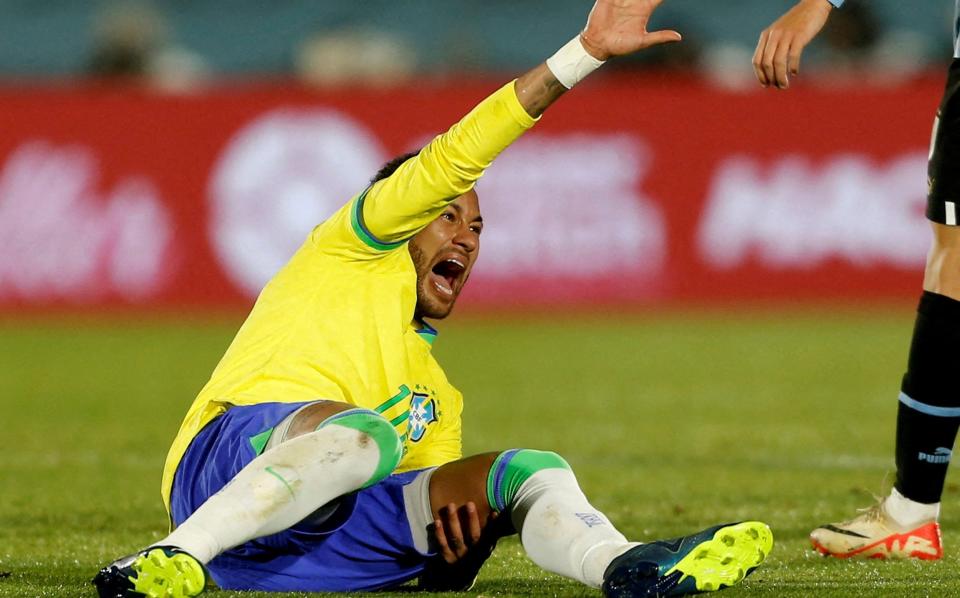One of them is in his thirties and has had most of a glorious career. The other is only 19 and there is so much more to come. Two players at different times in their lives, with different hopes and ambitions, but both felled by the same dreaded diagnosis: a torn anterior cruciate ligament (ACL).
For Neymar and Gavi, there’s no telling if life will ever be the same once they recover. Both are at the start of a long road, with Neymar undergoing surgery earlier this month and Gavi, the insanely talented Spanish midfielder, set to do the same in the coming days.
It is an injury perhaps the most feared in football, and Neymar and Gavi are far from the only elite stars to have felt the pain this season. In the Premier League, Aston Villa’s Emi Buendia and Tyrone Mings, Arsenal’s Jurrien Timber and Chelsea’s Wesley Fofana have all suffered the same setback in recent months.
There are many more throughout Europe. And within women’s sports, where research shows that female athletes are up to six times more likely to suffer a non-contact ACL injury than their male counterparts, the number of serious knee injuries is a source of constant anxiety and fear.
There is currently no obvious solution to the problem. But that doesn’t mean a solution will never be found and there is a glimmer of hope in Scotland – in the form of a small ball bearing.
The idea comes from Knox Chate, an independent product developer based in Edinburgh. Chate’s background is in designing trainers, rather than football boots, but for the past four years he has been working on a product that he believes could reduce the risk of serious injuries, including ACL injuries, in a variety of sports.
Chate’s design is known as the “anti-grip stud,” and it’s essentially a stud with a ball bearing on the end – similar to a ballpoint pen, but larger. The goal is to reduce “rotational traction,” allowing smoother changes in direction and reducing the risk of studs becoming stuck in the turf, which is a leading cause of serious injury.
Studies have shown that high levels of rotational traction are associated with a significant increase in the risk of lower extremity injuries, especially ACLs. Chate’s goal was to lower that traction without compromising the fundamental purpose of the studs.
Obviously, if all the studs on the sole of your shoe had ball bearings, you would slide across the field. Chate’s recommendation is therefore that only three anti-slip studs be used at a time – in the parts of the foot through which most pressure passes when an athlete changes direction (one at the base of the big toe, and then two at the heel) .
“You still need traction,” Chate told Telegraph Sport. “You just don’t need too much of it, because then you get stuck and get injured. You need the right amount.
“It’s not a medicine [for serious injuries]. But it’s like a seat belt. It doesn’t mean you can’t have accidents, but it does reduce the risk. That is the objective.”


At this early stage, the stud is primarily designed for artificial surfaces. But Chate has no doubt it would function effectively on the “hybrid” pitches used by many clubs in the professional game. On soft, boggy grass it wouldn’t be effective in its current form, but if the surface is firm the ball will hopefully slide into the stud (especially if it’s greased).
Now for the inevitable caveat: these are indeed just the early years, and much more research into the technology is needed. There is still a long way to go before top athletes can screw anti-slip studs into the soles of their boots.
However, the preliminary research is promising. The studs were examined in a study by the University of Stirling’s Physiological Research Group, in which a collection of amateur male rugby players underwent tests on acceleration, slaloming and sprinting.
The results showed that participants experienced a slight decrease in straight-line acceleration speed when wearing the anti-grip studs. But they made up for lost time slaloming between the cones, suggesting the anti-grip stud could help them change direction at high speed.
Since the stud is designed to help athletes change direction more smoothly, this was seen as an encouraging result. At the very least, it proved that the studs had a material impact on a player’s movement.


It was not the university’s goal to immediately see whether the studs reduce the risk of injury. Such scrutiny would take years.
“What we decided to do was see if we could identify known mechanisms of injury, particularly within football and rugby, and see if we can manipulate them using this study,” said Dr Lewis Macgregor, lecturer in physiology at the University of Stirling.
It’s too early to say for sure whether the studs actually manipulate these mechanisms, but Dr. Based on his preliminary research, Macgregor believes they merit further investigation. “From a purely scientific point of view I think it’s worth looking into this further,” he told Telegraph Sport.
Chate’s original plan for his Troup-O-One brand is to create a boot designed specifically for women. He adds that the door is open for his invention (which is patented) to be licensed for use by larger sportswear manufacturers.
For football as a whole, it is clear that something needs to change. Premier Injuries data shows that there have been 196 injuries since the start of this Premier League season – an increase of 15 percent compared to the last four seasons.
No stud or boot can ever completely prevent serious injury, and there isn’t enough definitive evidence yet to say that these anti-slip studs will definitely have an impact. But if they could indeed make a difference – even a small one – then surely those injured footballers, ruled out of action for months, would be the first to say they are worth a look.